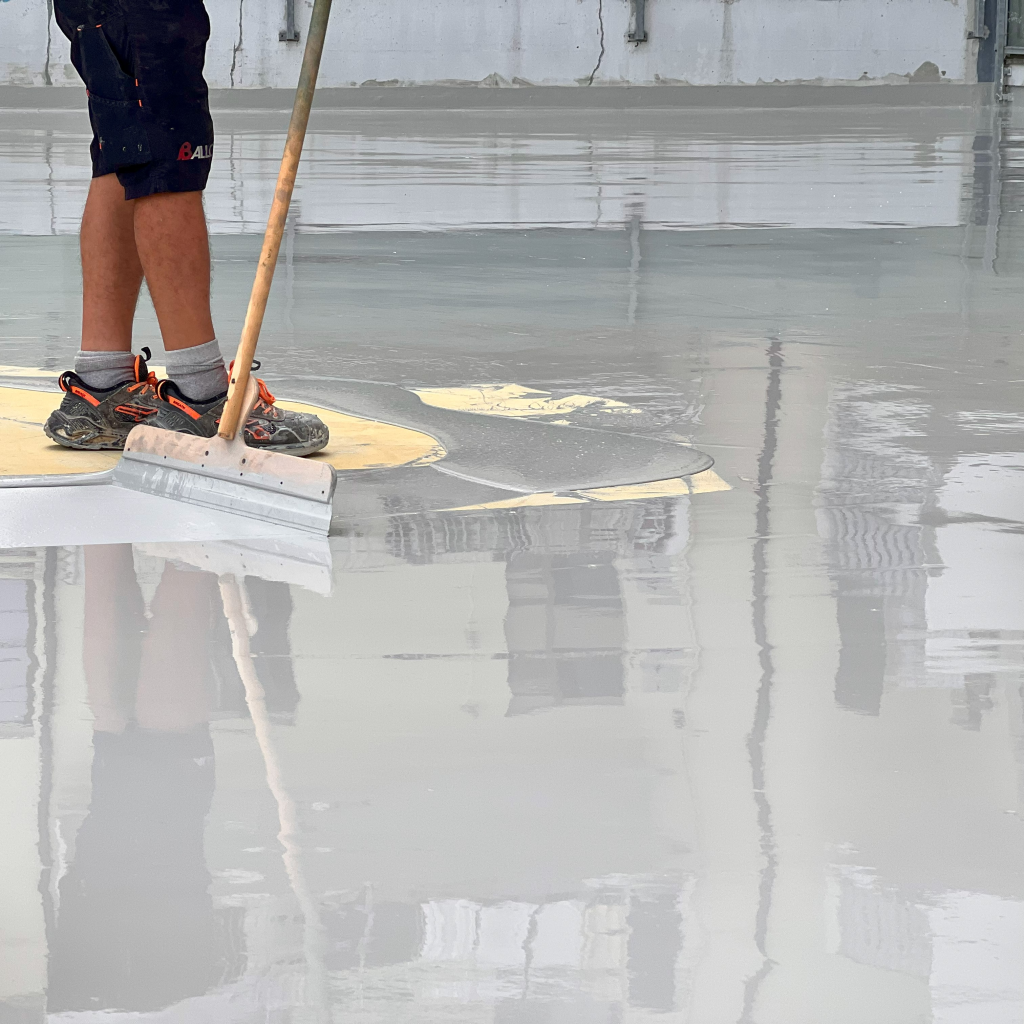



Moisture-free concrete surfaces
The surfaces to be coated must be stable, clean and free of substances that can affect the adhesion of the coating. In case of restoration, first use mortars and products from the FLOOR line or the REPAR line suitable for the purpose. Wait for the drying times before applying the next coating. The tensile strength of the support must not be less than 1.5 N/mm². Any existing paintwork, coatings or paints, residues of cement laitance, release agents, greases, silicones, etc. they can be removed mechanically by sanding with a single-brush sander, sandblasting, hydro-sandblasting or chemical removal, treating the support with DETERG A (diluted in water 1:10) left to act until the reaction is complete, then rinsing with water. Wait until the floor is dry before proceeding with the application of SYNTECH PAVICAR. The application surface must in any case be dry and free of humidity.
Cracks and fissures
In the case of static cracks, for sealing use the GROUT CABLE structural grout or mortars from the FLOOR line, or epoxy products such as SYNTECH PRIMER EP-W or SYNTECH AS 21. The sealing of dynamic cracks or cracks larger than > 4-5 mm must be evaluated on site. They can generally be grouted using elastomeric materials or worked as movement joints.
Localized grouting and restoration
Any holes, deficiencies, repairs of portions of concrete can be carried out by applying our mortars from the FLOOR line or the REPAR line. Any small filling of holes and gaps can be carried out by applying SYNTECH AS 21 epoxy mortar.
Creation of coves between horizontal and vertical joints
Create a connection shell at the horizontal-vertical joint points, at the technical and service points, using OSMOCEM SCK osmotic cement mortar, for a height of approximately 5 cm.
Resin coatings
The surfaces to be coated must be stable, clean and free of substances that can affect the adhesion of the coating such as dirt, grease, oil, etc. Sand the surface by mechanical sanding with diamond discs and dust extraction.
Tarred surfaces or with bituminous sheaths
The surfaces to be coated must be stable, clean and free of substances that can affect the adhesion of the coating. Any existing paint, coating or varnish must be removed by sandblasting, hydroscarifying, mechanical removal or scraping. Surfaces tarred or covered with bituminous sheaths must first be treated by applying OSMOCEM N osmotic grout mixed with an aqueous emulsion composed of one part by weight of water and one part by weight of BOND PLUS latex. Wait 48 hours after installing the waterproofing grout (depending on the season), then proceed with the application of the SYNTECH PAVICAR elastic waterproofing system.
Primer on concrete
On the adequately prepared support, apply a coat of SYNTECH PRIMER EP-S as a gripping primer, using a brush or medium-haired roller, taking care to saturate the entire surface to be treated. Wait 12-24 hours before applying the finish.
Support humidity control
Before installing resin systems and coatings, always check the residual humidity content of the support. Check for the presence of residual humidity using the plastic sheet method according to the ASTM D 4263 standard: fix a heavy polyethylene sheet with a size of at least 45x45 cm to the support with adhesive tape. 24 hours after its installation, lift the sheet and check for signs of humidity.
If testing with a carbide hygrometer, the moisture content of the substrate must be < 4% by weight.
In case of residual humidity, apply two or more layers of SYNTECH PAVIDAMP three-component epoxy primer.
Mixing
Thoroughly homogenize the individual components inside their container for at least 30 seconds by manual or mechanized stirring, taking care to use a clean tool free of potentially polluting substances. Combine the two components in the indicated mixing ratio. Add component B (hardener) into component A (base) and mix carefully until the product is completely homogenized. It is recommended to start mixing the components briefly using an electric drill at low speed and then intensify the stirring up to a maximum of 300 rpm. Avoid mixing times that are too long in order to limit the quantity of air incorporated into the product.
Application
On the adequately prepared support, pour SYNTECH PAVICAR onto the floor, distributing it evenly and homogeneously using a notched trowel, taking care to create a constant thickness and a continuous and coplanar surface. It is advisable to pass the bubble-breaking roller over the fresh product in order to eliminate any air bubbles created during the application phase of the self-levelling product. The correct action of the bubble-breaking roller allows for easy distribution of the product and avoids the formation of micro-holes which can jeopardize the uniformity and waterproofness of the coating. Once hardened, generally 24 hours after the first coat, apply a second layer of SYNTECH PAVICAR using a notched trowel or short-haired roller.
Painting
12-24 hours after completing the installation of the elastic waterproofing coating, apply a layer of solvent-based polyurethane finish SYNTECH PAVICROM PU. To obtain a uniform finish it is recommended to always keep one side fresh during the painting phases. The application of different thicknesses, for example due to the overlapping of different rolls, can lead to a difference in the final gloss.







Impact resistance
EN ISO 6272-1
Capillary absorption
EN 1062-3
Permeability to CO2
EN 1062-6
Dry residue
Brilliance
EN ISO 2813
Permeability to water vapor
EN ISO 7783-1
Working temperature
Adhesion by direct traction
EN 1542
Viscosity
Brookfield ASTM D 2196
Resistance to severe chemical attacks
EN 13529
Complete hardening at 20°C
Taber abrasion resistance
expressed as weight loss in
grams (H22 wheel - 1000 g - 1000 rpm)
EN ISO 5470-1
Time before second coat at 20°C
Touch hardening at 20°C
Approximately 2.0 kg of Syntech Pavicar for each square meter of surface to be covered, in two coats.